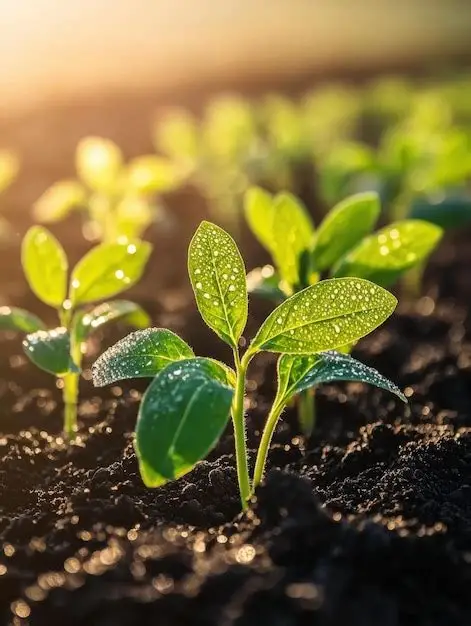Lignosulfonates, natural polymers derived from lignin during the sulfite pulping process, are increasingly valued as eco-friendly binders in seed coating applications. Their adhesive properties, biodegradability, and versatility make them a sustainable alternative to synthetic binders, supporting modern agricultural practices that prioritize environmental responsibility and efficiency.
What Are Lignosulfonates?
Lignosulfonates are water-soluble compounds produced as byproducts of the wood pulping industry. They come in forms like sodium lignosulfonate, calcium lignosulfonate, and magnesium lignosulfonate, depending on the metal ion used in processing. These compounds act like natural glue when mixed with water, helping to stick coating materials to seeds. Their ability to bind, disperse, and stabilize makes them useful for creating uniform seed coatings that improve planting and growth outcomes.
How Lignosulfonates Work in Seed Coating
Seed coating is a process where materials are applied to seeds to make them easier to plant, protect them from pests or harsh conditions, and help them grow better. Lignosulfonates serve as the “glue” that holds these materials together, ensuring they stay on the seed during handling and planting. They are used in three main types of seed coating:
- Pelleting: Lignosulfonates bind powders or other materials around small or irregularly shaped seeds to create uniform, round pellets. This makes seeds easier to plant with machines and can improve germination.
- Film Coating: A thin layer of lignosulfonate-based coating is applied to the seed, often carrying nutrients, pesticides, or beneficial microbes. This protects the seed without significantly changing its size.
- Encrusting: This is a middle ground between pelleting and film coating, where lignosulfonates add a thicker layer to increase seed size and weight for better handling, while still allowing the seed to “breathe” and germinate properly.
Why Use Lignosulfonates in Seed Coating?
Lignosulfonates offer several advantages that make them a popular choice for farmers, seed companies, and researchers looking for sustainable solutions. Here’s a detailed look at their benefits:
- Eco-Friendly and Sustainable:
- Lignosulfonates come from renewable sources (wood), making them a greener alternative to synthetic binders like polyvinyl alcohol (PVA) or petroleum-based polymers.
- They are biodegradable, breaking down naturally in the soil without leaving harmful residues, which aligns with the push for environmentally responsible farming.
- Improved Seed Handling:
- Seeds coated with lignosulfonates are uniform in size and shape, which makes them easier to plant using mechanical seeders. This is especially helpful for small or irregularly shaped seeds like lettuce or carrot seeds.
- The coatings reduce dust during handling, which improves worker safety and prevents seed loss.
- Pelleted seeds flow better through planting equipment, reducing clogs and ensuring even distribution in the field.
- Better Germination and Growth:
- Lignosulfonates can create a protective layer around seeds, shielding them from environmental stresses like drought or soil pathogens.
- Studies, such as those on Chinese cabbage, show that lignosulfonate coatings can boost germination rates and help seedlings grow stronger by providing a stable environment around the seed.
- They can also hold water near the seed, keeping it moist during early growth stages.
- Versatility with Additives:
- Lignosulfonates work well with other materials, such as nutrients (e.g., nitrogen, phosphorus), pesticides, or beneficial microbes like rhizobia (which help plants fix nitrogen).
- For example, sodium lignosulfonate has been shown to protect photosensitive pesticides like avermectin from UV light, making them more effective for longer periods.
- They can also stabilize coatings that include fertilizers, ensuring nutrients are released slowly to the seedling.
- Cost-Effective:
- As byproducts of the pulp industry, lignosulfonates are relatively inexpensive compared to synthetic binders, making them an economical choice for large-scale seed coating operations.
- Their multifunctionality (acting as binders, dispersants, and stabilizers) reduces the need for additional chemicals, further lowering costs.
- Additional Benefits:
- Lignosulfonates can improve soil structure around the seed by acting as a dispersant, which helps water and nutrients spread evenly in the soil.
- They have natural water-retaining properties, which can help seeds stay hydrated in dry conditions.
- Some formulations enhance the shelf life of coated seeds by protecting them from moisture or fungal growth during storage.
How Lignosulfonates Are Used in Practice
The application of lignosulfonates in seed coating depends on the seed type, the coating goal, and the equipment used. Here’s how they are typically applied:
- Pelleting Process:
- A mixture of lignosulfonate (usually 3-5% by weight) is combined with fillers like clay, talc, or organic materials. This mixture is sprayed or layered onto seeds in a rotating drum or coating machine.
- Water activates the lignosulfonate’s adhesive properties, binding the materials into a smooth, durable pellet.
- The final pellet typically has a moisture content below 7% to ensure stability during storage and planting.
- Film Coating:
- A liquid solution containing lignosulfonate and active ingredients (e.g., pesticides, nutrients, or dyes) is sprayed onto seeds in a thin layer.
- The coating dries quickly, leaving a protective film that doesn’t significantly change the seed’s size or weight.
- For example, sodium lignosulfonate mixed with carboxymethyl cellulose (CMC) has been used to create UV-resistant coatings for Chinese cabbage seeds, protecting pesticides from breaking down in sunlight.
- Encrusting:
- Lignosulfonates are used to apply a thicker coating than film coating but less bulky than pelleting. This increases seed size for easier handling while keeping the coating lightweight to avoid germination delays.
- Encrusting is common for crops like onions or beets, where precise planting is critical.
- Specialized Applications:
- Lignosulfonates can carry beneficial microbes, such as Trichoderma fungi, which protect seeds from soil-borne diseases.
- They are also used in fertilizer coatings, which can be integrated into seed treatments to provide nutrients directly to the seedling, reducing nutrient loss in the soil.
Challenges and Considerations
While lignosulfonates are highly effective, there are some challenges to keep in mind when using them as seed coating binders:
- Balancing Binder Concentration:
- Too much lignosulfonate can make the coating too tight, which might slow down or prevent germination by restricting water or oxygen access to the seed.
- Too little binder can cause the coating to crack or chip during handling, reducing its effectiveness.
- Typical concentrations range from 0.5% to 5% by weight, but this varies by seed type and coating method. Testing is often needed to find the right balance.
- Water Solubility:
- Lignosulfonates dissolve easily in water, which is great for applying coatings but can be a drawback in wet conditions where the coating might break down too quickly.
- To address this, lignosulfonates are sometimes combined with cross-linking agents (e.g., formaldehyde with CMC) to make the coating more water-resistant.
- Seed Surface Compatibility:
- Different seeds have different surface textures, which can affect how well lignosulfonates stick. For example, smooth seeds like corn may need a different formulation than rough seeds like grass.
- Pre-treating seeds or adjusting the coating mix can help improve adhesion.
- Regulatory and Safety Concerns:
- Lignosulfonates themselves are non-toxic and safe for use in agriculture, but coatings that include pesticides or other chemicals must follow strict regulations.
- For example, treated seeds are often color-coded (per FDA guidelines) to distinguish them from untreated seeds, ensuring safe handling and planting.
- Equipment and Process Adjustments:
- Coating equipment must be calibrated to handle lignosulfonate-based mixtures, as their viscosity and drying time differ from synthetic binders.
- Overheating during drying can damage seeds, so careful control of temperature and moisture is essential.
Practical Tips for Using Lignosulfonates
- Test Formulations: Start with a small batch to find the right lignosulfonate concentration and coating thickness for your specific crop and equipment.
- Combine with Additives: Use lignosulfonates with fillers like clay or talc for pelleting, or with polymers like CMC for water-resistant film coatings.
- Monitor Drying: Ensure coatings dry evenly to avoid clumping or seed damage. Keep moisture content below 7% for pelleted seeds.
- Check Regulations: If adding pesticides or dyes, verify compliance with local agricultural regulations, such as color-coding requirements for treated seeds.
- Store Properly: Coated seeds should be stored in cool, dry conditions to maintain coating integrity and seed viability.
Future Potential
As agriculture moves toward sustainability, lignosulfonates are likely to see growing use in seed coating. Researchers are exploring ways to enhance their water resistance and compatibility with new bio-based additives. Innovations like nano-lignosulfonates or hybrid coatings could further improve their performance, making them even more effective for precision farming and organic systems.
Conclusion
Lignosulfonates are a game-changer for seed coating, offering a sustainable, affordable, and versatile solution for improving seed handling, protection, and germination. Their ability to bind coatings, carry nutrients, and protect against environmental stress makes them ideal for modern agriculture. While challenges like water solubility and formulation precision require attention, careful planning and testing can unlock their full potential. Whether you’re a farmer looking to improve planting efficiency or a seed company aiming for eco-friendly products, lignosulfonates are worth considering.

